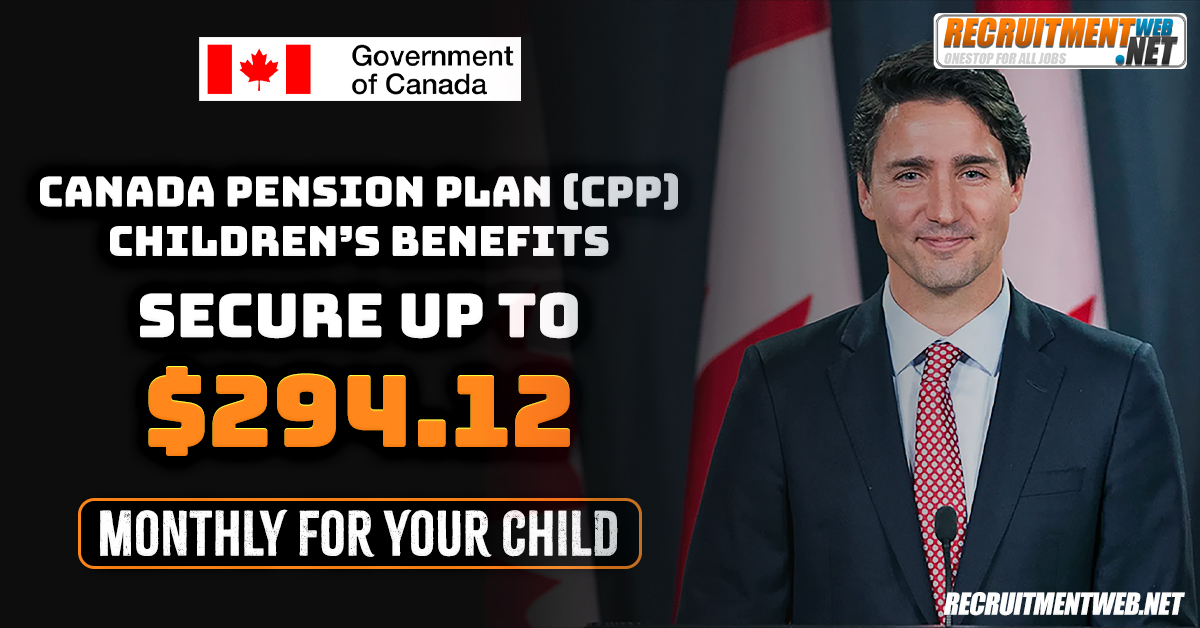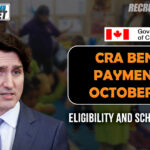Overview of the Canada Pension Plan (CPP) Children’s Benefits
The Canada Pension Plan (CPP) Children’s Benefits offer monthly financial support to children of deceased or disabled contributors. These benefits ensure that eligible children receive assistance to help with their living costs.
Eligibility Criteria for CPP Children’s Benefits
To qualify for CPP Children’s Benefits, the child must be a dependent of a CPP contributor who is either deceased or receiving CPP disability benefits. If the contributor has passed away, the child should be under 18. For children aged 18 to 25, they must be in full-time education at a recognized institution to remain eligible.

Eligibility also extends to biological, adopted, or custodial children of the contributor. The benefit provides financial assistance directly to help cover everyday expenses for eligible children during these critical stages of their lives.
The Role of Service Canada in Administering CPP Benefits
Service Canada plays a crucial role in managing the CPP Children’s Benefits. It is responsible for processing applications, verifying eligibility, and issuing monthly payments to qualified recipients.
To apply, you need to submit a completed application form along with necessary documents to a Service Canada office. They ensure that the benefits are calculated accurately based on the contributor’s CPP contributions and handle any questions or issues that might arise during the application process. Service Canada aids in ensuring that eligible children receive the financial support they need without unnecessary delays.
Understanding CPP Death and Disability Benefits for Canada Pension Plan Children’s Benefits
The Canadian Pension Plan (CPP) offers key benefits that provide financial support for families after a contributor passes away or becomes disabled. These benefits could include a lump-sum death payment, monthly pensions, and support for children.
CPP Death Benefit
The CPP Death Benefit is a one-time payment provided to the estate of the deceased contributor. This lump sum can help with immediate costs that arise, such as funeral expenses. To qualify, the deceased must have made enough contributions to the CPP. Typically, the amount is fixed at $2,500.
Getting this benefit requires an application from the executor of the estate or next of kin. It’s crucial to apply soon after the death to avoid delays. The benefit provides important financial relief during a difficult time.
CPP Disability Benefit and Its Impact on Children’s Benefits
The CPP Disability Benefit supports individuals who cannot work due to a severe and prolonged disability. Eligible recipients receive monthly payments that assist with living expenses. For a disabled contributor with children, there is a separate Disabled Contributor’s Children’s Benefit.
This children’s benefit is specifically for dependent children under 18, or up to 25 if they are in school. The 2024 rate for this benefit is $294.12 monthly per child. Applying promptly through Service Canada ensures that eligible children can receive these funds without disruption.
Survivor’s Pension for Dependents
The CPP Survivor’s Pension is a core benefit for families when a contributor dies. This monthly payment is provided to the surviving spouse or common-law partner. Its exact amount depends on the age and situation of the surviving partner.
For those aged 65 and over, the survivor’s pension can be up to 60% of the deceased contributor’s retirement pension. Meanwhile, dependents under 65 may receive a combination of a flat-rate and a percentage of the deceased’s pension. These payments aim to stabilize the financial situation of the family, ensuring economic support during challenging times.
Application Process and Payment Information for Canada Pension Plan (CPP) Children’s Benefits
The application process for CPP Children’s Benefits involves several steps, including online and paper forms. Payments are issued monthly, with options for retroactive payments in some cases.
How to Apply for CPP Children’s Benefits
To apply for the CPP Children’s Benefits, you can submit your application using the My Service Canada Account online system. This platform allows for a simpler process as you can track your application status. If you prefer, you can also apply using a paper form available at local Service Canada offices.
The key application forms include the ISP1400 for the child’s benefit. If the child is over 18 and still in school, a Declaration of Attendance form (ISP 1401C) is necessary. Ensure all sections are completed accurately to avoid delays. In cases where you don’t have direct custody, additional documentation proving control or custody might be needed.
Submitting the application requires having all relevant documents ready, such as your Social Insurance Number and any supporting documents requested. Verification steps are in place to confirm eligibility, so keeping your personal information up-to-date is important.
Understanding CPP Payment Dates and Retroactive Payments
CPP Children’s Benefits are paid monthly, typically on the third-to-last business day of each month. Dates can vary, so it’s important to check the current schedule throughout the year. Payments are direct-deposited into your bank account, ensuring timely access to the funds.
Retroactive payments might be available if there was an eligible period before your application was approved. If eligible, you’ll receive a lump sum for the months before approval, up to 12 months prior to the application date. Ensure all needed records are provided to claim any applicable retroactive amounts.
Staying informed about payment schedules and maintaining updated banking details will help avoid interruptions. If any issues arise, contacting Service Canada promptly can help resolve problems with delayed or missed payments.
Financial Details of Canada Pension Plan (CPP) Children’s Benefits
The Canada Pension Plan (CPP) Children’s Benefits offer financial support to eligible children of deceased or disabled contributors. This section outlines important details like how the monthly payment is calculated and the contribution rules that apply.
Calculating the Monthly Children’s Benefit
The flat rate for CPP Children’s Benefits in 2024 is $294.12 per month for each child. This amount is consistent annually, ensuring stable support.
Children qualify if they are under 18, or under 25 and enrolled in full-time education. This benefit helps ease financial burdens for families who have lost a primary wage earner due to death or disability. Each child receives their own payment, helping to support educational expenses and daily needs.
Contribution Rates and Maximum Pensionable Earnings
Contributing to the CPP is mandatory for working-age Canadians between 18 and 65. The contribution rate is 5.95% of your annual income, applicable to both employees and employers. If you’re self-employed, you must cover the full 11.9% yourself.
The maximum pensionable earnings for 2024 is set at $66,600. This cap limits the amount of income subject to CPP contributions. An annual basic exemption of $3,500 is also applied, which reduces the amount you must contribute. These contributions ensure the availability of benefits like the Children’s Benefit to those in need.
Integrating Canada Pension Plan (CPP) Children’s Benefits with Other Benifits
Understanding how the Canada Pension Plan (CPP) Children’s Benefits integrate with other Canadian benefits can be crucial. This integration helps maximize support from government programs and ensures you’re accessing all available resources.
Coordinating CPP Children’s Benefit with Other Government Programs
The CPP Children’s Benefit can work alongside other financial aids like the Guaranteed Income Supplement and Old Age Security. It’s important to check eligibility for various programs to receive the full range of benefits. For example, if you qualify for the Quebec Pension Plan, it may have different criteria or benefits.
Programs like the Old Age Security provide support based on age and residency, while the Guaranteed Income Supplement offers additional aid to low-income seniors. Always verify if the CPP Children’s Benefit can be combined with these to maximize potential assistance.
Understanding Combined Benefits and Top-Ups
Using resources like the Canadian Retirement Income Calculator can help you understand how CPP integrates with other programs. Knowing how different plans complement each other ensures a steady income for beneficiaries. Families may also explore top-ups to increase their monthly income from various sources.
For those receiving the CPP Post-Retirement Disability Benefit, understanding how this interacts with children’s benefits is vital. If you defer benefits, payments might increase, but understanding all possible top-ups and their eligibility criteria is crucial. Always review detailed information about each program, ensuring you are benefiting fully from the available support.
FAQ’s About Canada Pension Plan (CPP) Children’s Benefits
CPP Children’s Benefits help support children when a contributor to the Canada Pension Plan (CPP) has passed away. Eligibility, application processes, and benefit amounts are important aspects to consider.
How can I apply for CPP Children’s Benefits?
You can apply online through your My Service Canada Account (MSCA). This platform allows you to manage and submit applications for various CPP benefits easily.
Are there any age requirements for children to receive CPP Benefits?
To qualify, the child must be under 18, or if between 18 and 25, they must be attending a recognized school or university.
What documentation is needed to claim CPP Children’s Benefits?
You will need the child’s birth certificate, proof of the contributor’s death, and documents showing the child’s school enrollment if they are between 18 and 25.
How is the monthly CPP Children’s Benefit amount determined?
The benefit amount can change each year. Factors like the deceased contributor’s CPP contributions influence this. The maximum monthly amount is currently $294.12.
What happens to CPP Children’s Benefits if the recipient turns 18?
If the child turns 18 and continues their education, they may keep receiving benefits until age 25. Otherwise, benefits stop when they turn 18.
Can a child receive both CPP Children’s Benefits and the Canada Child Benefit?
Yes, these benefits can be received at the same time. Each has different eligibility requirements and purposes, so they do not interfere with each other.


